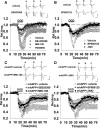RAGE inhibition in microglia prevents ischemia-dependent synaptic dysfunction in an amyloid-enriched environment
- PMID: 24966375
- PMCID: PMC4069353
- DOI: 10.1523/JNEUROSCI.0141-14.2014
RAGE inhibition in microglia prevents ischemia-dependent synaptic dysfunction in an amyloid-enriched environment
Abstract
Ischemia is known to increase the deleterious effect of β-amyloid (Aβ), contributing to early cognitive impairment in Alzheimer's disease. Here, we investigated whether transient ischemia may function as a trigger for Aβ-dependent synaptic impairment in the entorhinal cortex (EC), acting through specific cellular signaling. We found that synaptic depression induced by oxygen glucose deprivation (OGD) was enhanced in EC slices either in presence of synthetic oligomeric Aβ or in slices from mutant human amyloid precursor protein transgenic mice (mhAPP J20). OGD-induced synaptic depression was ameliorated by functional suppression of RAGE. In particular, overexpression of the dominant-negative form of RAGE targeted to microglia (DNMSR) protects against OGD-induced synaptic impairment in an amyloid-enriched environment, reducing the activation of stress-related kinases (p38MAPK and JNK) and the release of IL-1β. Our results demonstrate a prominent role for the RAGE-dependent neuroinflammatory pathway in the synaptic failure induced by Aβ and triggered by transient ischemia.
Keywords: entorhinal cortex; interleukin1-beta; jnk; neuroinflammation; p38mapk; synaptic transmission.
Copyright © 2014 the authors 0270-6474/14/348749-12$15.00/0.
Figures







Comment in
-
Neuroinflammation mediates synergy between cerebral ischemia and amyloid-β to cause synaptic depression.J Neurosci. 2014 Oct 8;34(41):13571-3. doi: 10.1523/JNEUROSCI.3196-14.2014. J Neurosci. 2014. PMID: 25297086 Free PMC article. No abstract available.
References
-
- Arancio O, Zhang HP, Chen X, Lin C, Trinchese F, Puzzo D, Liu S, Hegde A, Yan SF, Stern A, Luddy JS, Lue LF, Walker DG, Roher A, Buttini M, Mucke L, Li W, Schmidt AM, Kindy M, et al. RAGE potentiates Abeta-induced perturbation of neuronal function in transgenic mice. EMBO J. 2004;23:4096–4105. doi: 10.1038/sj.emboj.7600415. - DOI - PMC - PubMed
-
- Braak H, Braak E. Demonstration of amyloid deposits and neurofibrillary changes in whole brain sections. Brain Pathol. 1991;1:213–216. - PubMed
Publication types
MeSH terms
Substances
Grants and funding
LinkOut - more resources
Full Text Sources
Other Literature Sources
Molecular Biology Databases
Research Materials
